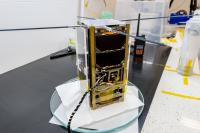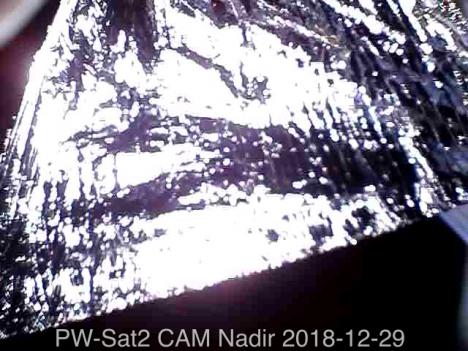Two Years Since the Launch of PW-Sat2
On 3 December 2018 at 7:32 pm, the second student-built satellite from the Warsaw University of Technology (WUT) was launched into orbit. During its mission, it carried out all planned experiments, including the most important one, i.e. a successful test of the innovative deorbit sail. We are currently waiting for the deorbiting of PW-Sat2 and the launch of its successor, i.e. PW-Sat3.
The team from the Astronautic Student Research Group at the WUT Faculty of Power and Aeronautical Engineering worked on PW-Sat2 for almost six years.
The sail first
Students designed a sail to prevent satellites that already completed their mission from remaining in orbit for a long time. At present, they stay there for many years after they finish their missions and ‘litter the space’. Thanks to the technology tested in PW-Sat2, the deorbiting time for nanosatellites can be shortened even to a few dozen months.
The sail is made of mylar film and constructed in such a way so that it takes up as little space as possible when folded (in the container). The diameter of the folded sail is ca. 8 cm.
“This is extremely important, because thanks to this our deorbiting system could be used in other nano- and microsatellites,” explains Dominik Roszkowski, Project Assistant Coordinator.
PW-Sat2 itself is a CubeSat-type satellite. It is a 10cm×10cm×22cm cuboid.
Successful experiments
According to its plan, the mission was supposed to last 40 days with the sail setting as the grand finale. Ultimately, the team decided to set the sail earlier. Less than a month since the launch, on 29 December 2018, just before 11.00 am, the sail was successfully unfolded in space.
“This was confirmed by photos and a time-lapse video as well as telemetry data transmitted from the satellite,” says Dominik Roszkowski.
The sail was the main experiment carried out as part of PW-Sat2 mission. In addition, during the mission certain devices and systems were tested, i.e. the Sun sensor (used to determine the spatial orientation of the satellite in orbit), cameras (recording the sail opening process), the solar panel unfolding mechanism and a system collecting information about the ionizing radiation dose absorbed.
Importantly, all experiments were designed by our students. About 100 people took part in the project. Thanks to this activity, many of them found jobs in the aerospace industry.
Historical photo of the Earth
Not only was it the date of the satellite launch and of the sail opening that made history, but also a unique photo. On 5 December 2018, PW-Sat2 took the first Polish satellite image of the Earth from space.
“The photo was taken when the satellite was over the Dutch coast and it pictures southern Sweden, thick clouds over Norway, a large part of the North Sea and even a fragment of our Baltic Sea,” says Dominik Roszkowski.
A new satellite
PW-Sat2 will be deorbited in about 60 days. The satellite will simply burn up in the Earth’s atmosphere. This process can be observed at: https://sail.pw-sat.pl/
A new team from the Astronautic Student Research Group has worked on PW-Sat3 for over two years now. Students are developing jet propulsion that will make it possible to perform a series of orbital manoeuvres.
As Marcin Pulik, PW-Sat3 Project Coordinator, explains: “We are finishing the initial design of our satellite. In the months to come, we will work, among other things, on the assembly of the first functional version of the jet engine and on its tests. At the same time, we will work on a model that will allow us to check whether the satellite is strong enough to withstand harsh conditions in space.”
The launch of PW-Sat3 is scheduled for 2023.
For more information about our students’ satellites, please visit the website and Facebook










